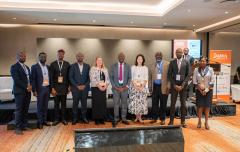Capital Crunch: Realizing Renewable Energy’s Potential in Africa Requires Fresh Thinking on Finance
Voices are growing stronger for decentralized renewable energy as a key solution for closing enormous electricity access gaps in developing countries.
“Decentralized energy is the fastest and cheapest source or energy. It needs to be at the heart of the UN’s energy work,” said Ambassador Ali Al Shafar, permanent representative of the United Arad Emirates to IRENA, speaking in September at the United Nations General Assembly.
H.E. Seleshi Bekele, Minister of Water, Irrigation and Electricity of Ethiopia echoed him at the same meeting.
Despite the recognition, however, the sector suffers from a critical problem – it isn’t attracting serious money to grow in a serious way.
Global progress in delivering power to a billion people who have no electricity at all has been disappointingly slow in large part because of this lack of capital. Vast rural populations far removed from centralized electric grids are especially well suited for decentralized renewables, such as household solar systems, which can be installed more quickly, at less cost and deliver energy services immediately.
The dearth of financing was clear in a recent Energizing Finance report series produced by Sustainable Energy for All (SEforALL) and other groups. Tracking finance commitment on electricity access in 20 African and Asian countries, only 1 percent - about $200 million a year - was flowing to off-grid enterprises. The vast majority of the money – nearly $20 billion a year on average - was going to centralized electricity infrastructure, such as power plants and transmission line extensions, which are more expensive and time consuming to build.
A second report, based on interviews with decentralized enterprise executives and financiers operating in five African and Asian countries – Bangladesh, Ethiopia, Kenya, Myanmar and Nigeria - reaches the same conclusions. Citing common hurdles such as high collateral requirements for loans, lack of debt financing and local currency challenges, finance commitments for off-grid enterprises “are a fraction of what is needed to scale their businesses exponentially,” the report concludes.
But the Taking the Pulse report saw some positive indicators, too. Bangladesh, for example, has made inroads providing reasonably priced debt financing to renewable energy enterprises through its state-owned financing company, IDCOL (Infrastructure Development Co. Ltd.) IDCOL has provided lower-cost financing for millions of home solar systems and, more recently, microgrids that are powering farm irrigation systems and remote islands.
Kenya has helped enable pay-as-you-go (PAYGO) solar companies such as M-KOPA Solar which are providing basic electricity to over a half-million households at a fraction of the cost of traditional electric grid projects. Among the reasons for Kenya’s PAYGO success: a robust mobile phone/mobile money market that enables households to finance their solar systems; ready access to foreign exchange, a relatively stable local currency; and relatively simple procedures for importing solar equipment.
(Hot off the press: Kenya’s M-KOPA Solar this month received $80 million of new commercial financing, most of it in local currency, the largest debt financing deal to date in the PAYGO off-grid sector. The money will be used in the next three years to help finance solar installations in one million homes in East Africa – on top of 500,000 already connected.)
Still, there is no soft pedaling the profound changes that will be needed to elevate off-grid financing levels to billions of dollars every year, not just millions. The five countries in the Taking the Pulse report alone will require an estimated $55 billion in financing to scale decentralized renewable energy enterprises at levels that are needed to achieve universal energy access targets.
So what will it take to stimulate such a profound shift? Here are a few key recommendations from the Taking the Pulse report, co-authored by Practical Action Consulting, E3 Analytics and SEforALL:
First, government leaders must develop integrated electrification strategies that emphasize both centralized AND decentralized energy, and put in place supportive energy and investment policies and regulations that make off-grid enterprises more “investable” for all types of asset classes, including debt, equity and grants.
Second, countries need to make it easier and less costly for enterprises to qualify for loans from local banks. High collateral requirements and other requirements are simply too onerous for most renewable energy enterprises, especially local ones. A softening of lending standards, such as allowing a wider range of assets to be considered in loan request, could help encourage local currency lending and availability of local currency debt.
Third, donors, development finance institutions and impact funds should be especially focused on targeting efforts to support enterprises to deliver services in especially remote regions – stimulating delivery of electricity access to the ‘last mile.’
The urgency for stimulating more financing could not be stronger. Progress on achieving universal electricity access goals by 2030 is behind schedule and each year of delay is another year of depriving populations the wide-ranging dividends that decentralized electricity solutions deliver faster and at lower costs.
“We’re not just talking about leaving on the lights,” said Rachel Kyte, Special Representative to the UN Secretary General for Sustainable Energy for All and CEO of Sustainable Energy for All. “We’re talking about education, medicine and irrigating fields.”



